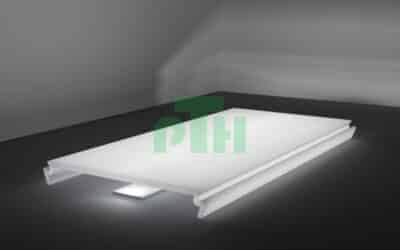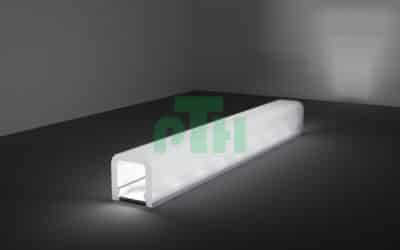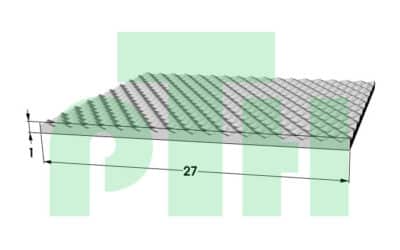Il policarbonato V0 flame retardant (ritardante di fiamma) è un materiale di alta qualità, appositamente formulato per garantire eccellenti proprietà ignifughe. Questo lo rende ideale per applicazioni in cui la sicurezza contro il fuoco è una priorità, come nel settore elettrico, automobilistico, dei trasporti, ospedaliero e delle costruzioni. Il policarbonato V0 flame retardant è la scelta ideale per chi cerca un materiale che offra una combinazione di sicurezza antincendio, trasparenza e resistenza meccanica per tubi e profili. Le sue caratteristiche lo rendono adatto per applicazioni critiche in vari settori, garantendo qualità e affidabilità nel tempo.
| Physical | Nominal Value Unit | Test Method |
|---|---|---|
| Density | 1.25 g/cm3 | ISO 1183 |
| Melt Volume-Flow Rate (MVR) | - | ISO 1133 |
| 300°C/1.2 kg | 3.00 cm3/10 min | - |
| 300°C/2.16 kg | 5.50 cm3/10 min | - |
| Molding Shrinkage - Flow2 | 0.40 to 0.60% | Internal Method |
| Water Absorption | - | ISO 62 |
| Saturation, 23°C | 0.32% | - |
| Equilibrium, 23°C, 50% RH | 0.13% | - |
| Mechanical | Nominal Value Unit | Test Method |
|---|---|---|
| Tensile Modulus | 2350 MPa | ISO 527-2/1 |
| Tensile Stress | - | ISO 527-2/50 |
| Yield | 65.0 MPa | - |
| Break | 70.0 MPa | - |
| Tensile Strain | - | ISO 527-2/50 |
| Yield | 7.0% | - |
| Flexural Modulus3 | 2350 MPa | ISO 178 |
| Flexural Strength3,4 | 95.0 MPa | ISO 178 |
| Taber Abrasion Resistance | - | Internal Method |
| 1000 Cycles, 1000 g. CS-17 Wheel | 9.00 mg | - |
| Impact | Nominal Value Unit | Test Method |
|---|---|---|
| Charpy Notched Impact Strength 4,5 | - | ISO 179/1eA |
| –30°C | 10 kJ/m2 | - |
| 23°C | 11 kJ/m2 | - |
| Charpy Unnotched Impact Strength5 | - | ISO 179/1eU |
| –30°C | No Break | - |
| 23°C | No Break | - |
| Notched Izod Impact Strength6 | - | ISO 180/1A |
| –30°C | 10 kJ/m2 | - |
| 23°C | 11 kJ/m2 | - |
| Unnotched Izod Impact Strength6 | - | ISO 180/1U |
| –30°C | No Break | - |
| 23°C | No Break | - |
| Hardness | Nominal Value Unit | Test Method |
|---|---|---|
| Ball Indentation Hardness (H 358/30) | 95.0 MPa | ISO 2039-1 |
| Thermal | Nominal Value Unit | Test Method |
|---|---|---|
| Heat Deflection Temperature7 | - | - |
| 0.45 MPa, Unannealed, 100 mm Span | 148°C | ISO 75-2/Be |
| 1.8 MPa, Unannealed, 100 mm Span | 135°C | ISO 75-2/Ae |
| Vicat Softening Temperature | - | - |
| – | 155°C | ISO 306/B50 |
| – | 156°C | ISO 306/B120 |
| Ball Pressure Test (125°C) | Pass | IEC 60695-10-2 |
| CLTE-Flow (23 to 80°C) | 0.000070 cm/cm/°C | ISO 11359-2 |
| Thermal Conductivity | 0.20 W/m/K | ISO 8302 |
| Electrical | Nominal Value Unit | Test Method |
|---|---|---|
| Surface Resistivity | 1.0E+15 ohms | IEC 60093 |
| Volume Resistivity | 1.0E+15 ohm cm | IEC 60093 |
| Relative Permittivity | - | IEC 60250 |
| 50 Hz | 2.70 | - |
| 60 Hz | 2.70 | - |
| 1 MHz | 2.70 | - |
| Dissipation Factor | - | IEC 60250 |
| 50 Hz | 0.0010 | - |
| 60 Hz | 0.0010 | - |
| 1 MHz | 0.010 | - |
| Electric Strength (3,20 mm, in Oil) | 17 kV/mm | IEC 60243-1 |
| Flammability | Nominal Value Unit | Test Method |
|---|---|---|
| Flame Rating - UL (1.50 mm) | V-0 | UL 94 |
| Glow Wire Flammability Index (1.00 mm) | *850 °C *960 °C | IEC 60695-2-12 |
| Optical | Nominal Value Unit | Test Method |
|---|---|---|
| Refractive Index | 1.586 | ISO 489 |
| Transmittance (2540 μm) | 88.0% | ASTM D1003 |
| Haze (2540 μm) | < 0.80% | ASTM D1003 |
| Drying Temperature | 120°C | - |
| Drying Time | 2.0 to 4.0 hr | - |
| Hopper Temperature | 100 to 120°C | - |
| Cylinder Zone 1 Temp. | 260 to 300°C | - |
| Cylinder Zone 2 Temp. | 260 to 290°C | - |
| Cylinder Zone 3 Temp. | 260 to 290°C | - |
| Adapter Temperature | 240 to 280°C | - |
| Melt Temperature | 260 to 300°C | - |
| Die Temperature | 240 to 300°C | - |
| Calibration Temp, First | 50.0 to 100°C | - |
Notes
1 Typical properties: these are not to be construed as specifications
2 Tensile Bar
3 2.0 mm/min
4 Yield
5 80*10*3 sp=62 mm
6 80*10*3
7 120*10*4 mm


